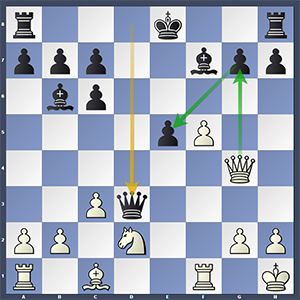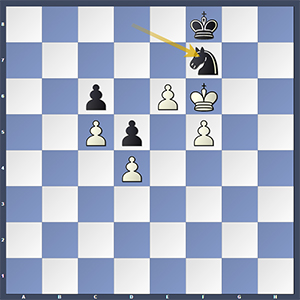
Round five of the London Chess Classic 2016, took place on December 13th, in Olympia, London. It would be the last round before the one and only rest day. At such times, one never really knows what to expect, the players could come out looking to do something with a day to recover, or they could decide to lengthen their recovery, content with a nice easy draw.
This was the case in Aronian-Giri, who barely got out of theory in their ‘game’ (term used loosely) before repeating and calling it a day in 20-moves.
Luckily, the other games were less feeble, even though the round only saw one decisive game. This came from English Grandmaster, Michael Adams, who inflicted further pain on the out of sorts Veselin Topalov. Playing White in a Berlin Defence, Adams played very aggressively and Topalov was unfortunately the trouble maker for himself. 16…Qd3(?) was an inaccuracy which allowed White a powerful initiative.
Black never recovered from this, heavily hampered by White’s advanced passed pawn on f7 and a very unharmonious piece setup, which included a loose King. Adams had the point in 33-moves, but really the game was in his hands well before this. A very unfortunate situation for Veselin Topalov, who has only achieved half a point in the five rounds so far. It will be interesting to see whether he can recover for the resumption of the tournament and do something in the remaining rounds — but his mission is more a case of damage limitation and respectability now.

Adams was the only player to take a full point in the round, but Hikaru Nakamura did his best to take one from Vladimir Kramnik. Their Queen’s Gambit Declined followed a game that Kramnik had played (also with Black) against Pavel Eljanov at the Baku Olympiad this year. When Nakamura deviated with 17.g3 (Eljanov had played Ne2), it seemed to indicate that this was with intention and that proved to be the case.
White enjoyed a nice comfortable position, with slightly the better stance and did his best to make something of it, even sacrificing a piece in order to obtain two connected passed pawns. Frustratingly for Nakamura, the ever resourceful and experienced Kramnik, had things under control and found 58…Nf7(!), a great defensive move, which stopped White in his tracks. White was unable to push through in any line, with taking the knight meaning stalemate.

Fabiano Caruana also had chances with Black against Maxime Vachier-Lagrave, who was punished for rather unambitious play with the White pieces. Caruana equalised without problem and stood the more positive of the two even before 19.Bc1(?) from White allowed Black to pass his e-pawn, a very strange decision indeed.
Unfortunately, with his opponent under some pressure, Caruana opted for 24…Rd2, (24…Nb4), which gave White an out and left Black with a much reduced edge, if any. A further ten moves and Black was settling for only shared spoils.
So-Anand saw White get the best out of the opening following Black’s novelty of 10…Bxa3. Exchanges arrived soon after, however and the game was rather uneventful, ending in a draw in 30. I think So will be quite content, especially as the rest of the results mean that he leads at the rest day — only by a half point though, so this is nothing to be sat on.
As already said, the players now have a rest day, with play resuming on December 15th.
- So — 3.5
- Aronian, Nakamura, Kramnik, Caruana — 3.0
- Giri, Anand — 2.5
- Adams, Vachier-Lagrave — 2.0
- Topalov — 0.5
[Site “London ENG”]
[Date “2016.12.13”]
[Round “5.1”]
[White “So, Wesley”]
[Black “Anand, Viswanathan”]
[Result “1/2-1/2”]
[ECO “D37”]
[WhiteElo “2794”]
[BlackElo “2779”]
[PlyCount “60”]
[EventDate “2016.12.09”]
{ Annotations by John Lee Shaw for www.hotoffthechess.com. }
1. d4 Nf6 2. c4 e6 3. Nf3 d5 4. Nc3 Nbd7 5. Bf4 dxc4 6. e3 b5 7. Nxb5 Bb4+ 8.
Nc3 Nd5 9. a3 Nxc3 10. Qd2 Bxa3 {A new approach by Anand, …Nd5 and …Ne2
had been played before with ok results for Black.} 11. Qxc3 Bd6 12. Bxd6 (12.
Bxc4 Bxf4 13. exf4 Bb7 14. O-O O-O {with White having Ne5 or Rfc1 as possible
continuations.}) 12… cxd6 13. Bxc4 O-O 14. O-O Bb7 15. Be2 Qb6 16. Rfc1 Rfc8
17. Qa3 Bxf3 18. Bxf3 Rab8 {The play up to this point has resulted in a small
edge to White, who has slightly more infuence on the position. His Bf3 is a
nicer piece than Black’s Nd7.} 19. h4 (19. Rc3 d5 20. Rac1 Rxc3 21. bxc3 Rc8 {
and Black isn’t doing too badly.}) 19… Rxc1+ 20. Rxc1 Qxb2 21. Qxb2 Rxb2 22.
Rc7 Nf8 23. Rxa7 {The game is unlikely to go anywhere from here, the players
don’t seem up for it in this round.} d5 24. Ra8 g6 25. g3 h5 26. g4 hxg4 27.
Bxg4 Kg7 28. h5 gxh5 29. Bxh5 Ng6 30. Bxg6 Kxg6 {a draw was agreed here.}
1/2-1/2
[Event “London Chess Classic 2016”]
[Site “London ENG”]
[Date “2016.12.13”]
[Round “5.2”]
[White “Vachier-Lagrave, Maxime”]
[Black “Caruana, Fabiano”]
[Result “1/2-1/2”]
[ECO “C42”]
[WhiteElo “2804”]
[BlackElo “2823”]
[PlyCount “67”]
[EventDate “2016.12.09”]
{ Annotations by John Lee Shaw for www.hotoffthechess.com. }
1. e4 e5 2. Nf3 Nf6 3. Nxe5 d6 4. Nf3 Nxe4 5. Nc3 Nxc3 6. dxc3 Be7 7. Be3 Nc6
8. Qd2 Be6 9. O-O-O Qd7 10. b3 O-O-O {A novelty. Castling short would have
been a bit sharper.} 11. Nd4 a6 12. Nxe6 fxe6 13. g3 {This strikes me as not
very ambitious play from White.} d5 14. Bh3 Kb8 15. Rhe1 Rhe8 16. f4 Bf6 17.
Kb1 Qd6 {Black has solved his problems very nicely and is equal at worst here.}
18. Qd3 e5 19. Bc1 {a slip, allowing Black to pass his e-pawn. I don’t really
understand this decision by Vachier-Lagrave.} (19. fxe5 Nxe5 20. Qd4 Nc6 21.
Qd3 d4 {and Black is the much more positive of the two.}) 19… e4 {with the
best of things.} 20. Qd2 {Qe3 was a better choice, this is a very passive and
defensive position.} Qc5 21. Bb2 d4 {this is not a bad choice, but advancing
the e-pawn further may have offered more.} (21… e3 22. Qe2 d4 {and White is
being heavily punished for his slow play.}) 22. Qe2 dxc3 {White is in severe
trouble, here.} 23. Rxd8+ Rxd8 24. Bc1 Rd2 {This is a blunder, throwing away
Black’s advantage in one move. Such a dramatic undertaking was not necessary, .
..Re8 or …Nb4 was perfectly powerful enough.} (24… Nb4 25. Qxe4 {there is
nothing better} Nd3 {the knight cannot be taken — cxd3 would leave …c2 mate,
and Qxd3 loses the Queen to …Rxd3 for the same reason.} 26. Qe3 {with …Rd4
or …Qxe3 perfectly good for Black.}) 25. Bxd2 cxd2 26. Qxd2 Bc3 27. Qc1 Bxe1
28. Qxe1 e3 {Unfortunately, Black does not have the resources to make this
pawn count now.} 29. c3 Na7 30. Bf1 Nb5 31. Kb2 Qa3+ 32. Kb1 {the beginning of
repetition.} Qc5 33. Kb2 Qa3+ 34. Kb1 {And the players agreed a draw, here.}
1/2-1/2
[Event “London Chess Classic 2016”]
[Site “London ENG”]
[Date “2016.12.13”]
[Round “5.3”]
[White “Nakamura, Hikaru”]
[Black “Kramnik, Vladimir”]
[Result “1/2-1/2”]
[ECO “D37”]
[WhiteElo “2779”]
[BlackElo “2809”]
[Annotator “Shaw,John Lee”]
[PlyCount “121”]
[EventDate “2016.12.09”]
{ Annotations by John Lee Shaw for www.hotoffthechess.com. }
1. d4 Nf6 2. c4 e6 3. Nf3 d5 4. Nc3 Be7 5. Bf4 O-O 6. e3 Nbd7 7. c5 Nh5 8. Bd3
Nxf4 9. exf4 b6 10. b4 a5 11. a3 c6 12. O-O Ba6 13. Re1 {repeating a line that
Kramnik had against Eljanov at the Baku Olympiad in September of this year.
The game was a draw, does Nakamura think he can do better?} Bf6 14. Ne5 Bxe5
15. fxe5 Bxd3 16. Qxd3 Ra7 17. g3 {The new move. Eljanov had played Ne2.} Qa8 {
A potent move, firing along the a-file, pressuring b4 and a1.} 18. Rab1 {
very prudent, I think this is the only move to be honest.} axb4 19. axb4 Ra3
20. Qc2 Rb8 21. h4 h6 22. Kg2 Qa6 23. Rec1 bxc5 24. bxc5 Rxb1 25. Qxb1 Qc4 {
I think Black will be quite satisfied here.} 26. Qb2 Rb3 27. Qd2 Qb4 28. Rc2 f6
29. f4 fxe5 30. fxe5 Nf8 31. Ne2 Qb7 {A signal that Black is not comfortable
with his backward pawns and wants to keep material on. This is mainly a
defensive decision.} (31… Qxd2 32. Rxd2 Ng6 33. Ra2 Ne7 34. h5 Kf7 35. Ra7
Ke8 36. Kf2 {and White definitely has the most influence in this position, but
as to whether it has the potential to be a decisive one is another matter.})
32. Nf4 Qf7 33. Rb2 Rxb2 {There is not really anything better than making this
exchange, …Ra3 was also possible, but Black was possibly worried about
becoming passive.} 34. Qxb2 g5 35. hxg5 hxg5 36. Nd3 Ng6 37. Nf2 Ne7 {I am not
sure that moving the knight was a good decision, White wants to play g4 and
Nh3 in order to target the g5-pawn, so I think the knight belonged on g6, in
order to hop to f4. Waiting moves, such as …Kg7 may have been better.} 38.
Qd2 Qg6 39. g4 {Fixing the g-pawn, Black is somewhat on the back foot now.} Kg7
{The King is now key to holding the g-pawn.} 40. Nh3 Kh6 41. Kg3 Nc8 42. Qf2
Kg7 {Black can’t really afford Qf6.} 43. Qe3 Kh6 44. Qf3 Kg7 45. Qa3 {Deciding
to not repeat, but instead changing tact.} Qe4 46. Nxg5 {There was not really
anything better than this, but it leads to a totally equal position. White has
nothing.} Qe1+ 47. Kf4 Qf2+ 48. Nf3 Ne7 49. Qa7 Kf8 50. Qb8+ Kf7 51. Qb7 Kf8
52. Qd7 Ng6+ 53. Kg5 {Giving a piece in order to achieve two connected passed
pawns.} Qxf3 {Black had no choice but to go along with this, anything else was
super for White.} 54. Qxe6 Nh8 55. Qf5+ Nf7+ 56. Kf6 Qxf5+ 57. gxf5 {This
looks a nice situation, but unfortunately White does not have the
possibilities to make these pawns count. Black has resources enough to hold
this position, as Kramnik is about to reveal.} Nd8 58. e6 Nf7 {A wonderful
defensive resource from Vladmir Kramnik, offering his piece in return for a
draw by stalemate.This setup is worthy of comitting to memory, as White has no
way around it.} 59. Kg6 Nd8 60. Kf6 {White realises that there is no way to
force through and so accepts the draw.} Nf7 61. exf7 1/2-1/2
[Event “London Chess Classic 2016”]
[Site “London ENG”]
[Date “2016.12.13”]
[Round “5.4”]
[White “Aronian, Levon”]
[Black “Giri, Anish”]
[Result “1/2-1/2”]
[ECO “D77”]
[WhiteElo “2785”]
[BlackElo “2771”]
[PlyCount “40”]
[EventDate “2016.12.09”]
1. g3 d5 2. Nf3 g6 3. Bg2 Bg7 4. d4 Nf6 5. O-O O-O 6. c4 dxc4 7. Na3 c5 8. Nxc4
Be6 9. b3 Nc6 10. Bb2 cxd4 11. Nxd4 Nxd4 12. Bxd4 {A new move, here, the Queen
having recaptured previously. Don’t get too excited, though, this game is
really a non-starter.} b6 13. Rc1 Rc8 14. Rc2 b5 15. Ne3 Rxc2 16. Nxc2 Qa5 17.
Qa1 Qd2 18. Qd1 Qa5 19. Qa1 Qd2 20. Qd1 Qa5 {And the players agreed a draw
here, obviously not up for a long day.} 1/2-1/2
[Event “London Chess Classic 2016”]
[Site “London ENG”]
[Date “2016.12.13”]
[Round “5.5”]
[White “Adams, Michael”]
[Black “Topalov, Veselin”]
[Result “1-0”]
[ECO “C65”]
[WhiteElo “2748”]
[BlackElo “2760”]
[PlyCount “65”]
[EventDate “2016.12.09”]
{ Annotations by John Lee Shaw for www.hotoffthechess.com. }
1. e4 e5 2. Nf3 Nc6 3. Bb5 Nf6 4. d3 Bc5 5. Bxc6 dxc6 6. Nbd2 Be6 7. O-O Bd6 8.
d4 Nd7 9. Nxe5 Nxe5 10. dxe5 Bxe5 11. f4 Bd4+ 12. Kh1 f6 13. c3 {The usual way
of continuing here, had been f4-f5, which is arguably the best move. Things
are not so simple, though, obtaining a playable position that gets the
creative juices flowing is often as important as plusses and minuses. Anyway,
Adams has a different approach.} Bb6 14. f5 Bf7 15. e5 {White is not hanging
about in this game, Adams has come out with his sleeves rolled up.} fxe5 {
This is quite forced.} 16. Qg4 Qd3 {? A slip from Topalov, allowing White to
pounce.} 17. Qxg7 Rg8 18. Qxe5+ {Obviously, White has a very big position here.
} Kd7 19. Qe4 {A pawn to the good, and with a fine position that includes a
Kingside pawn majority, White seeks exchanges.} Qa6 20. f6 Rae8 (20… Rad8 21.
Qxh7 Kc8 22. Re1 {sees White very much in command. Note that taking the Bf7
instead would be very embarrassing and nicely met by …Qe2.}) 21. Qf5+ {
Already, White has a very powerful position and Black is struggling badly.} Kd8
22. c4 Qa5 23. Qh3 Qb4 24. Qxh7 {Just one of the very nice continuations
available.} Qf8 {It is very instructive to see just what influence White’s
f7-pawn has over Black’s pieces, here.} 25. b3 Bd4 26. Qd3 Qd6 27. Ne4 {
Ba3 was perhaps more direct, here, but White is still sitting pretty.} Qd7 {
This allows White to pile on the pressure along the d-flie, but it is very
difficult to suggest alternatives for Black, who has experienced something of
a collapse and the damage has been done and is irreversible. Most testing was
probable …Rxe4, but it was unlikely to have changed anything.} (27… Rxe4
28. Qxe4 Bxa1 29. Bf4 Rg4 30. Bxd6 Rxe4 31. Be7+ Ke8 32. Rxa1 {is going to be
a very painful ending for Black.}) 28. Rd1 Kc8 29. Qxd4 Qg4 30. Bg5 Rxe4 {
This move has no effect now and just straight loses.} 31. Qxa7 {finishing
powerfully} Bd5 32. Qa8+ {Stopping mate, Qa8, by masking the rook along the
d-file} Kd7 33. Rxd5+ {The correct way to proceed, and here Veselin Topalov
resigned. A very dominant game by Michael Adams.} 1-0
[/pgn]

